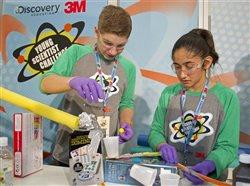Fostering your child’s love for science could ‘STEM’ the tide of job shortages
(BPT) - Middle school is a make-or-break time for budding scientists.
The subject matter gets more difficult, test anxiety often occurs and other interests emerge. U.S. students rank 27th in math and 20th in science out of 34 countries scored, according to the latest research from the Organization for Economic Cooperation and Development. That lagging interest in STEM — science, technology, engineering and mathematics — is contributing to an ongoing U.S. shortage of highly-skilled workers that may reach 3 million by 2018.
3M, a company rooted in science, understands the need for the next generation of science innovators, inventors and leaders. For decades, 3M scientists and engineers have developed products that solve problems and improve lives. A shortage of STEM-savvy workers will slow innovation across all industries.
If your child has a passion for science, encourage their curiosity. Here are some ideas from 3M science experts on how to further foster a love of science:
1. Find an after school program or STEM mentor.
A high-quality STEM after school program leads to improved attitudes toward STEM fields and careers; increased STEM knowledge and skills; and higher likelihood of pursuing a STEM major in college according to a study from the Afterschool Alliance. Another option is to find a mentor. Teachers, college students and working professionals are often eager to share their knowledge with budding young scientists. Many universities and businesses encourage mentorship, and your school’s science teachers might have some suggestions on where to find one that’s right for your child.
2. Plan at home experiments.
According to 3M science mentors, taking science out of a book and applying it to real life is one of the best ways to spark an interest in science. You can find plenty of science experiments to conduct inside your home. A great resource is www.scienceofeverydaylife.com, which features fun activities that explain science principles, like how solar energy works by cooking a pizza with the sun or how chemical reactions function by making homemade ice cream.
3. Encourage exploration.
As interest grows, students are eager for more challenges. For instance, with the Summer Olympics on the horizon this year, a sport-loving student may want to explore more about the forces that impact gold medal-quality swimming, running or cycling. Linking science to another interest can further their passion.
4. Give them a challenge.
A range of opportunities exist for interested students at science-based summer camps, after school programs or fairs. If your child is already on a path of science experimentation and innovation, consider encouraging him or her to enter science challenges and competitions. Each year 3M and Discovery Education partner to develop the Young Scientist Challenge. Students in grades 5-8 can enter the contest by creating a one to two-minute video on a proposed solution to solve an everyday problem. All video entries must be submitted online at www.youngscientistchallenge.com by April 20, 2016.
5. Hit the road.
Going to an observatory or space museum is fun, but also a major learning opportunity. Before taking the trip, view the destination’s website with your child and identify areas of particular interest. That will build anticipation and really amplify the visit.
Over its nine years of involvement in the Discovery Education 3M Young Scientist Challenge, 3M has seen the tremendous impact a parent, family member or mentor can make in a child’s curiosity and confidence in science. That foundation yields strong critical thinking skills and opens the door for rewarding career opportunities with lasting benefits.























